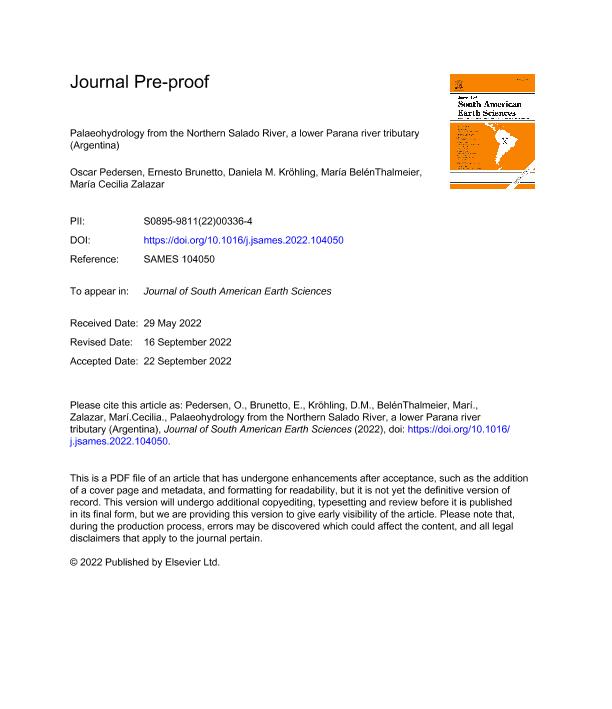Artículo
Palaeohydrology from the Northern Salado River, a lower Parana river tributary (Argentina)
Pedersen, Oscar Ariel ; Brunetto, Ernesto
; Brunetto, Ernesto ; Krohling, Daniela Mariel Ines
; Krohling, Daniela Mariel Ines ; Thalmeier, Maria Belen
; Thalmeier, Maria Belen ; Zalazar, Maria Cecilia
; Zalazar, Maria Cecilia
 ; Brunetto, Ernesto
; Brunetto, Ernesto ; Krohling, Daniela Mariel Ines
; Krohling, Daniela Mariel Ines ; Thalmeier, Maria Belen
; Thalmeier, Maria Belen ; Zalazar, Maria Cecilia
; Zalazar, Maria Cecilia
Fecha de publicación:
09/2022
Editorial:
Pergamon-Elsevier Science Ltd
Revista:
Journal of South American Earth Sciences
ISSN:
0895-9811
Idioma:
Inglés
Tipo de recurso:
Artículo publicado
Clasificación temática:
Resumen
Palaeofloods and drainage palaeostage can be approached from sedimentological, stratigraphical, geomorphological, geodetic, and geophysical information. This allows us to supply pre-instrumental and historical data and to assess a particular flood-prone area. It has been proved that the study of Late Holocene fluvial sediments is valuable source to estimate 1 × 102-1x103yr. scale occurrence and long-term recurrence of maximum events. The geological evidence of palaeofloods in lowlands in Central Argentina may reveal higher discharges likely occurred in the near past. In this work, we attempt to identify sedimentological evidence of past floods in Late Holocene sediments from the northern Salado River (NSR), an important tributary of the lower Paraná River basin (Chaco-Pampean plain region). In the yr. 2003, the lower reaches of the NSR recorded an extreme flood event that provoked a disaster in Santa Fe, a city of 500,000 inhabitants located at the river mouth. Considering the importance of this event, we developed a geomorphometry methodology for discriminating different levels of fluvial terraces and flood indicators in a representative area of the NSR, using multi-scale resolution Digital Elevation Model (DEM) data. Descriptions of flood-associated fluvial landforms and sedimentological stratigraphic attributes were performed in the field. High-resolution geodetic information and digital optical images were obtained from UAV photogrammetry. Ground Penetrating Radar (GPR) cross-sections were achieved and addressed to detect extreme flood evidence. A geomorphometric routine was applied to simulate the extreme flood scenarios, based on the data obtained from the field. The map resulting from the simulation was compared to satellite images recorded in the yr. 2003 extreme flood. A series of slackwater deposits and other palaeostage indicators (SWD-PSI) showed elevations higher than those reached over the yr. 2003 extraordinary flood (instrumentally recorded) and in the yr. 1914 historic flood event. The geomorphometric simulation of a flood event, calibrated from these diagnostic landforms, allowed us to extend the flood-prone area beyond the boundaries of the current active floodplain and channel. The integrative methodology enabled the mapping of areas potentially prone to flooding. The estimations of the discharges associated to the inferred palaeofloods could be 50–80% larger than the maximum events historically documented and instrumentally measured.
Archivos asociados
Licencia
Identificadores
Colecciones
Articulos(CCT - SANTA FE)
Articulos de CTRO.CIENTIFICO TECNOL.CONICET - SANTA FE
Articulos de CTRO.CIENTIFICO TECNOL.CONICET - SANTA FE
Articulos(CICYTTP)
Articulos de CENTRO DE INV.CIENT.Y TRANSFERENCIA TEC A LA PROD
Articulos de CENTRO DE INV.CIENT.Y TRANSFERENCIA TEC A LA PROD
Citación
Pedersen, Oscar Ariel; Brunetto, Ernesto; Krohling, Daniela Mariel Ines; Thalmeier, Maria Belen; Zalazar, Maria Cecilia; Palaeohydrology from the Northern Salado River, a lower Parana river tributary (Argentina); Pergamon-Elsevier Science Ltd; Journal of South American Earth Sciences; 120; 9-2022; 1-44
Compartir
Altmétricas



